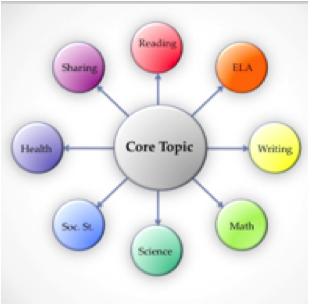Engaging in Godly Play
The third grade class, seated in a circle around the Desert Bag, were coming to the end of the Godly Play lesson of “The Ark and the Tent.” Our tent was a reconstructed shoe box, painted gold, with large pieces cut out so that the children could see inside. The items were the ark, a menorah, altars, etc. The whole was partly obscured by pieces of fabric or leather to indicate the special coverings. We had been considering what it takes to get ready to come close to God. On an impulse, I picked up the coverings and placed them completely over our tent box. There was a gasp from the group.
 Comments flew around the circle: “now it would be dark in the tent,” “the sun could shine in a bit,” “but there would be the light from the lamps,” and “we can still come close to God in the dark and God can come close to us.”
Comments flew around the circle: “now it would be dark in the tent,” “the sun could shine in a bit,” “but there would be the light from the lamps,” and “we can still come close to God in the dark and God can come close to us.”
This last statement is very meaningful for the children. They have seen from various other lessons how people and God have come close to each other. They are piecing together their spiritual language.
* * *
Some think that children are like empty vessels waiting to be filled with knowledge given them by adults.  However, this view ignores the truth that each one of us—children included—are created in the image of God. Children are more than just empty vessels. If we observe carefully we will see that children have much inside already.
However, this view ignores the truth that each one of us—children included—are created in the image of God. Children are more than just empty vessels. If we observe carefully we will see that children have much inside already.
The early years of childhood are spent by the child trying to give words to what they intuitively are aware of. Jerome Berryman, the deviser of Godly Play, wanted to find a way whereby children could develop a religious language which would give meaning to what they knew but couldn’t express. After extensive research and work with children, Berryman and his wife combined the discovery-learning style that their own children were experiencing in their Montessori school and Berryman’s own theological training. Each session begins by welcoming children into the circle of community. Facilitators then share a story from the scriptures and invite the children to wonder about it. This wondering leads into a time of creative response or play. Sessions end with a feast (snack) and blessing.
Godly Play is much more than an interesting way to tell Bible stories. It has, in fact, more in common with the practice of spiritual companionship. Adults and children together discover where God is working in their lives. Godly Play seeks to help the children to think theologically and maintain their sense of wonder and mystery. It’s a doorway into Spirit-led transformation.
As the facilitator of Godly Play, the Story Teller learns all the lessons in the Godly Play curriculum by heart. But adult and child, we learn and practice as we go. This learning together in community with children is both humbling and delightful. It can be challenging to wonder what Jesus meant when He said that unless we, the adults, become like little children, we will not enter the Kingdom of Heaven. What is it about children and Jesus’ relationship with them that we need to somehow copy? One thing is that as adults we can share in the serious play of spiritual nurture.
Godly Play supports the significance of play in the life of the child. It leaves space in the lesson for silence, slowness, and personal discovery. In the creative response time children will busy themselves building with wooden bricks, modeling with clay, drawing, etc. Some times the bricks become Nineveh or some other biblical place. In my classroom recently, they became a Prayer Labyrinth. This intentional response time allows children the opportunity to deeply engage in the creative process which gives space for them to work on big questions about life. In a safe environment they can give themselves permission to think about difficult issues such as death, meaning, aloneness, and the threat of freedom without having to explain their thoughts to an adult. This is their own discovery-learning time: a space for the Holy Spirit to meet the individual child.
For more information about Godly Play, you can visit the Godly Play Foundation webpage. They have resources and training available in a variety of languages (including English and German) and in many countries around the world.
Helen Spencer
Godly Play Specialist
TeachBeyond Eurasia
Born and brought up in the UK, Helen Spencer has been involved in overseas mission work since the middle 70s mostly in Eastern Europe. After her youngest son graduated from high school (BFA), she was introduced to Godly Play. She now practices and teaches Godly Play in eastern Europe where she is involved with Baby English Club. Helen has found that the elements of Godly Play bring together three of the areas of life that are important to her–creativity (art), storytelling (drama), and nurturing children–and this has a continuing positive impact on her life.
Photo Credits: tabernacle. shelia.blogspot. Storyteller. N. Spencer.






